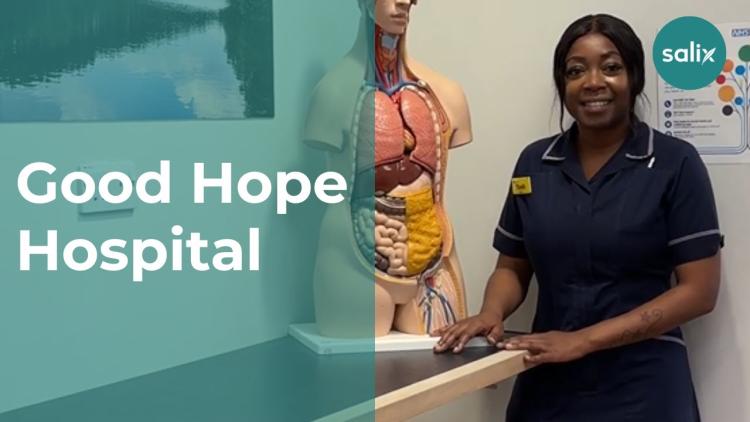Patients get the benefit of net zero technology on hospital wards

Good Hope Hospital Matron Natasha is very aware of the patient demographics at the hospital, which serves a large elderly population. Here teams are always anxious to avoid airborne disease accumulating in the air in wards. This is why the new technology with its better temperature control and ventilation systems are paramount.
Fewer infections and a more comfortable stay are key drivers in decarbonisation at Good Hope Hospital
As much as medical teams are passionate about treating patients in our hospitals – they would rather they were not there at all, and they certainly want to get them home as soon as possible.
Whilst news headlines often focus on waiting lists and doctor numbers, it could be easy to forget the importance of ‘air’ and how it impacts patient recovery. In fact, one of the most-important factors that impacts hospitals, patients, and healthcare in general, is the air that we breathe.
Air quality and temperature control in healthcare is fundamental.
On a recent visit to Good Hope Hospital, Sutton Coldfield, we sat down with Matron Natasha Salmon to talk about the Public Sector Decarbonisation Scheme project at the site and most crucially, how getting the right temperature on the wards is so crucial to her patients.
Good Hope Hospital, serving North Birmingham, Sutton Coldfield as well as parts of southeast Staffordshire, is one of four acute hospitals part of University Hospitals Birmingham NHS Foundation Trust (UHB). It serves around 450,000 people.
Good Hope Hospital was allocated £12,506,872 under the Public Sector Decarbonisation Scheme. This has allowed the hospital to install heat pumps, commission a new low-temperature-hot-water system and decommission the existing steam distribution system.
The new technology means including state of the art Building Management Systems controls installed to all plantrooms allowing better control of heating and hot water systems. This enables a more energy efficient system and a better environment for patients, staff and visitors.
But what exactly does this mean for patient care?
Natasha became a registered nurse in 2015 and has worked at Good Hope since 2022, before that she was at Queen Elizabeth Hospital Birmingham.
She is passionate about patient care and has worked across a number of wards from gastro and endoscopy to bowel disease. Her role as matron means she can take an overview of best practice.
For her, temperature control is not just about being warmer – it is a critical part of patient care.
Natasha said: “This is what I have always wanted to do. My role means that now I can make change, be innovative and always look at what is in the best interest of patients.
“The air and temperature control are so important to how people feel and how they recover.”
The air and temperature control are so important to how people feel and how they recover.
Natasha is very aware of the patient demographics at Good Hope Hospital, which serves a large elderly population. Here teams are always anxious to avoid airborne disease accumulating in the air in wards. This is why the new technology with its better temperature control and ventilation systems are paramount.
It’s not only good for the planet – but it’s good for how patients recover.
By carefully monitoring temperature and humidity, the risk of airborne diseases spreading can be reduced significantly.
Natasha added: “Having an environment that is warm is key to patient recovery, we have an aging population, and this is an old building.
“If we move people into a cold environment there is a high chance they will develop coughs and stay in hospital longer.
“A cough, a cold, a chest infection will mean that a patient will stay longer with a great chance of developing a hospital infection.
“As much as we want to care for people, we don’t want them to stay here too long.
“Also, a patient in critical care are vulnerable to temperature fluctuations.
“I am very interested in the patient stay and that when people are here it is a positive experience, and the quality of care is excellent.
“I will be interested to see the impact of the new technology on hospital stay, this is something we can monitor for the future.”
The better controlled rooms also mean patients, as well as staff can be more comfortable. Cold temperatures create risk.
This is something Natasha feels particularly strong about. She added: “We cannot have people coming in from a cold home to a cold hospital, this is not acceptable for any of us.
“We must protect our patients.”
We cannot have people coming in from a cold home to a cold hospital, this is not acceptable for any of us.
We must protect our patients.
The recommended room temperature for hospitals is between 19 degrees and 23 degrees Celsius.
As well as creating a more comfortable environment, the new building management control systems with the ability to better control temperature and ventilation, can also be used to contain and control airborne germs and diseases.
Today Natasha cares about her patients, but for tomorrow she cares about the future generations.
“We all have to take net zero seriously, climate change is on our doorstep. The extreme temperatures, whether the deep cold or the heat of the summer impacts our admissions and how we live our lives.
“Here at Good Hope Hospital, we’ve made a start.”
The NHS has set a target to reach net zero by 2040 for the emissions the NHS controls directly. It also aims to reach net zero by 2045 for the emissions the NHS has the ability to influence.
There is huge ambition at Good Hope, and this is reflected in projects across the country, as organisation work towards net zero goals.



